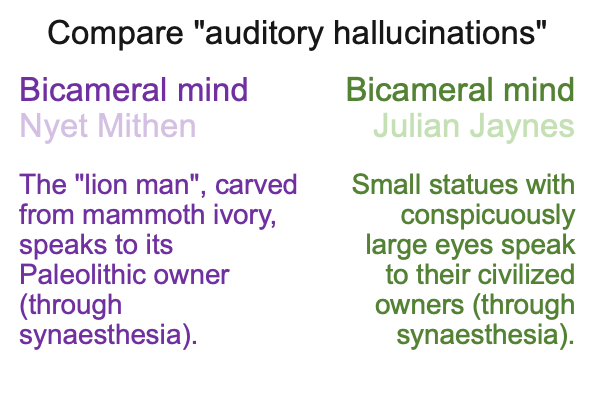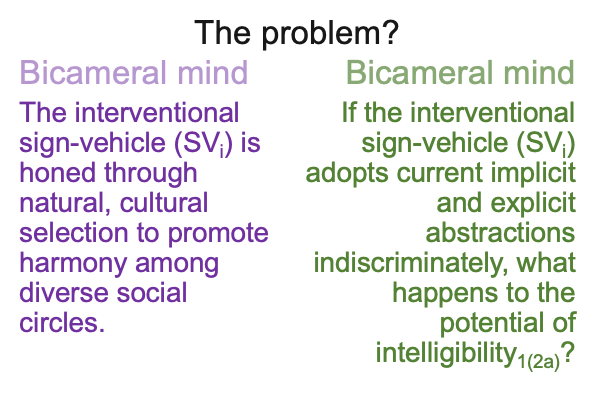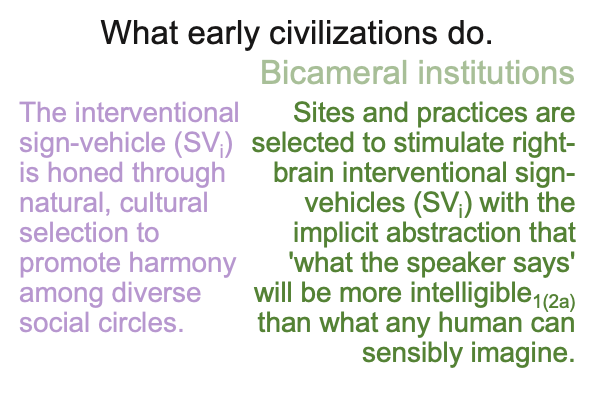0503 This first look at The Origin of Consciousness in the Breakdown of the Bicameral Mind, by Julian Jaynes, makes fun of the term, “auditory hallucinations”.
Why?
It turns out that the term applies to SVi(SOi), the dual actualities of the interventional sign relation.
It also turns out to be the embodiment of what evolutionary anthropologist, Steven Mithen, calls “synaesthesia” or “cross-modal sensations” that explain why spoken words exist.
0504 Indeed, a weird divergence comes to the surface in Looking at Steven Mithen’s Book (2024) The Language Puzzle(appearing in Razie Mah’s blog in September 2025).
0505 Steven Mithen asks, “Why do spoken words exist?”
His conscious answer is that they are acquired through synaesthesia in regards to things themselves. In other words, interactions with things themselves somehow trigger stable vocal utterances, or spoken words, through… well… leaky neurons.
Yet, some other intelligence operates beneath the surface of his conscious answer. His bicameral mind inspires him to admit that he rejects the gestural origin of language outright, because no current research into natural language deals with gestural language. That makes sense, because all civilized people only practice speech-alone talk.
0506 Yet, the inadmissibility of Mithen’s conscious admission triggers a search, by this reader, for clues to an alternate hypothesis, which this examination provides. After the domestication of fire and after the evolution of voluntary neural control of the vocal tract, vocal utterances are added as adornments to hand-talk. This habit contributes to the emergence of our own species, Homo sapiens, who practices hand-speech talk from the beginning.
0507 So, Mithen’s synaesthesia is not like… working with neuronal crossover… from encountering things themselves to auditory assignments.
0508 Rather, synaesthesia becomes a cultural practice during night-time communal hand-talk. Vocal utterances clarify hand-talk word gestures when they are difficult to see in the flickering light of a campfire. Then, synaesthesia from the Wernicke’s region on the right trains the Wernicke’s area on the left to automatically decode either hand-talk or speech-talk or both. Hand-speech talk is then practiced night and day.
0509 The habit of synaesthesia does not stop there, because sensory-modal crossover supports the logic of adornment. A spoken word adorns a hand-talk word-gesture. Likewise, ochre adorns skin. Soon, seashells are strung on fiber to adorn ankles and necks. Each of these adornments speak to the actuality of what they are adorning.
After humans interbreed with Neanderthals, between 65 and 45kyr, humans begin to carve and mold figures in earnest. These artifacts speak for themselves. This is synaesthesia at its most robust. The visual realness of say, the lion-man,crosses over into the auditory realness of what the lion-man has to say.
After the first singularity, Julian Jaynes attributes the large eyes of Mesopotamian temple statuary to synaesthesia. The large eyes trigger “auditory hallucinations”, where divine commitment2c induces meaning-filled species impressa2a.
0510 Here is a picture.

0511 However, there is a problem.
Our current Lebenswelt is not the same as the Lebenswelt that we evolved in.
0512 In the Lebenswelt that we evolved in, the intervention sign-relation is honed through natural… or is it cultural?… selection to promote harmony among diverse social circles. What the lion-may says is always in tune with what needs to be done to stay alive in a hostile world.
In our current Lebenswelt, explicit abstractions from one generation are taken to be implicit abstractions by the next. So, the way that an explicit abstraction divides the world, say, between experts and the people that are supposed to benefit from expertise, becomes implicit, and then more explicit abstractions are added, then they become implicit, until elite expert “voices” no longer make sense to the ones who are being ordered around.
0513 What is amazing is that, without introspection, elites follow their own bicameral voices with um… “mindless” obedience.

Does any of this seem vaguely familiar?
0514 So, how does one solve the problem of authorization?
This is the topic of Book III of Jaynes’s masterwork.
0515 Many solutions are ingenious. They tend to use tricks to stimulate interventional sign-vehicles2c (SVi) that yield, through the two-chambered mind, oracular proclamations2a (SOi), that may be regarded as ‘more intelligible that what the questioner can achieve on his or her own’1(2a).
For example, an oracle tells Socrates that he is the wisest philosopher on earth (SOi). So, Socrates spends the rest of his life trying to show that the oracle is wrong, which turns out to be an effective way to demonstrate that no one is as wise as Socrates (SVi).
0516 Here is a picture of what happens as consciousness slowly arises, during the breakdown of the bicameral mind.

The statement on the left describes the bicameral mind before the first singularity.
The statement on the right describes how civilizations attempt to rescue, maintain and (maybe even) exploit the bicameral mind, as it gets clogged down with explicit abstractions (that are absorbed into the next generation’s implicit abstractions).
0517 Yes, as soon as I start wondering whether my phantasm2b is intelligible, I engage in introspection, and a whole new vocabulary is needed. These words arrive as explicit abstractions, that attain the qualities of implicit abstraction, then those qualities are formalized into recipes, and then those recipes are considered to be the essence of whatever the thing that we have labeled must be.
What have we labeled this thing?
“Subjective consciousness?”
0518 Remember that Jaynes’s term, “auditory hallucination” serves as a label for SVi(SOi).
